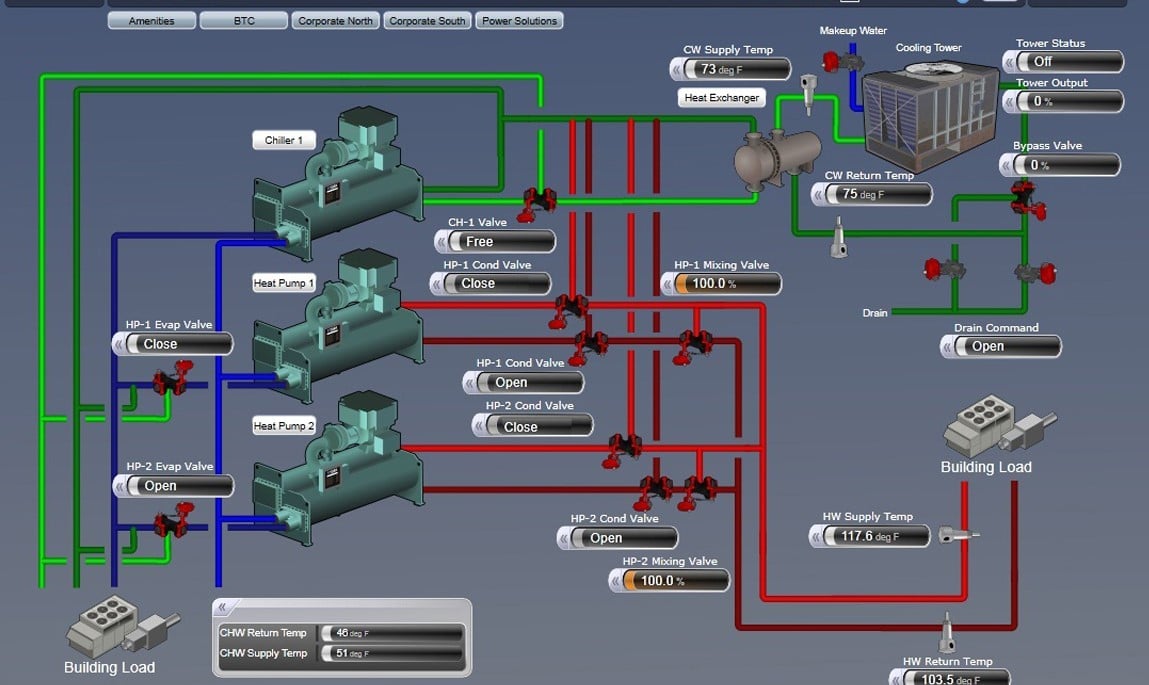Energy Efficiency | February 27, 2020
HVAC Overview Part I: Back to Basics with Heating and Cooling
Ever explain HVAC systems to someone and watch their eyes glaze over? Ever try to wrap your head around HVAC and what makes it important? HVAC, or Heating, Ventilation and Air Conditioning systems are complex and custom-engineered to serve their own facilities.
There are four fundamentals of HVAC for commercial and industrial buildings
-
Heating (boilers)
-
Cooling (chillers)
-
Movement (air handlers)
-
Hydro (water pumps)
-2.png?width=993&name=HVAC%20part%20III%20(1)-2.png)
We’ll cover these four basics in our HVAC Overview series. To kick it off, we’re tackling the two most important pillars to HVAC systems: heating and cooling.
We should note: all claims and information in this overview series are inevitably site-specific and rely on how a space is being used and occupied. Many HVAC facts and system information can vary based on facility design so all systems should be evaluated and managed by experienced technicians and engineers.
What is heating?
Heat is created by a variety of primary sources, such as fossil fuels, biomasses, and electricity, among others. In order to generate heat, no matter which type, a primary heat source is necessary. The ability to get the most heat transfer from the primary source to the secondary source will result in higher operating efficiencies. When looking to make an HVAC system more efficient you must look at the arguments for these systems.
Most HVAC systems have a boiler as the central piece of equipment powering a heating system. Heat is measured in the energy required to generated it, either kWh (kilowatt hours) if generated from electricity or therms in BTU (British thermal units) if generated by gas or oil.
How do steam systems work?
Steam has long been considered “most efficient” for making power. The temperature of steam starts at 212° F making it hotter than hydronic systems where the temperature is typically 180° F. This means that the hotter air should take longer to cool, therefore, the temperature stays warmer longer, because it starts higher.
The average end temperature is ~70° F for most offices, bearing this in mind, hydronic heat runs at 180° F which is cheaper to get to. However, this has more wasted energy and requires steam traps. Steam traps catch the cooled air (back in water form) and the water goes back to the boiler to be heated again.
Electricity is the least efficient way to heat an industrial space due to the comparative cost of kWh and therms.
What are hydronics?
Hydronics utilize hot water pumps which move heated water. Hydronic systems can save energy by varying the pumping speed based on demand. Because of the ability to program the pumps to the building load, hydronics are the modern “most efficient” heating systems.

This diagram shows an example of an HVAC system and how multiple components work together to heat and cool a building. Photo By: William S. Farrow
What is cooling?
Unlike heating, cooling is not made. Cooling is the process of removing heat from a space with the thermodynamic principles of heat transfer. Chillers are one of the more common methods of cooling (absorbing heat) in commercial and industrial HVAC applications. There are two types of chillers we will look at:
1. AIR –
Air cooled chillers are very common in HVAC facilities. Typically air-cooled chillers are located outside and don't require interconnecting piping for the heat rejection system. They will come as a packaged unit and typically only require a supply and return chilled water connection.
The upfront cost is cheaper in an air-cooled chiller due to the less intensive installation requirements, but the electrical consumption is higher than that of a water-cooled chiller. This is due to the fact that an air-cooled chiller uses air only as a means of heat rejection.
2. WATER –
A water-cooled chiller will have the heat rejection equipment (evaporative condenser, cooling tower) as a separate piece of the system. This will require the interconnecting piping we mention above and dependent on the size, the pipe can get upwards of 20” in diameter. This can lead to a higher initial cost of installation. However, the ability of the chiller to utilize water and air in the heat rejection process, will end up in efficiency gains.
Heating and cooling are the most basic elements to an HVAC system. How well they are designed, maintained and run over time can affect the efficiency – and cost – of running a building.
Understanding these systems and how they work together is critical for making choices and improving the efficiency of your HVAC equipment.
HVAC Overview Pt. II - RTUs and AHUs »
HVAC Overview Pt. III - Pumps »
Questions about your own HVAC system?
Related Posts
Discover more content and insights from Mantis Innovation

The Cost of Inaction: Why Businesses Should Act Now on Energy Efficiency
In today's fast-paced business environment, the financial and operational losses businesses incur by delaying energy efficiency improvements, the "cost of inaction," is more relevant than ever.

In today’s AI era, human intelligence is the key to data center facility and energy optimization
Nowhere else in modern industry do artificial and human intelligence converge with such transformative potential as in the world of data centers. As AI's extraordinary growth accelerates demand for

Your Guide to LED Lighting for Business and Commercial Buildings
Never to be underestimated, LED lighting and well-designed lighting retrofits and upgrades offer businesses big improvements like reduced energy costs, reduced emissions, and improved working

Five Trends Driving Data Center Facility Energy Optimization
Today’s digital economy, commercial and industrial digitalization, and the recent explosion in artificial intelligence and machine learning (AI/ML) powered computing are driving massive growth in